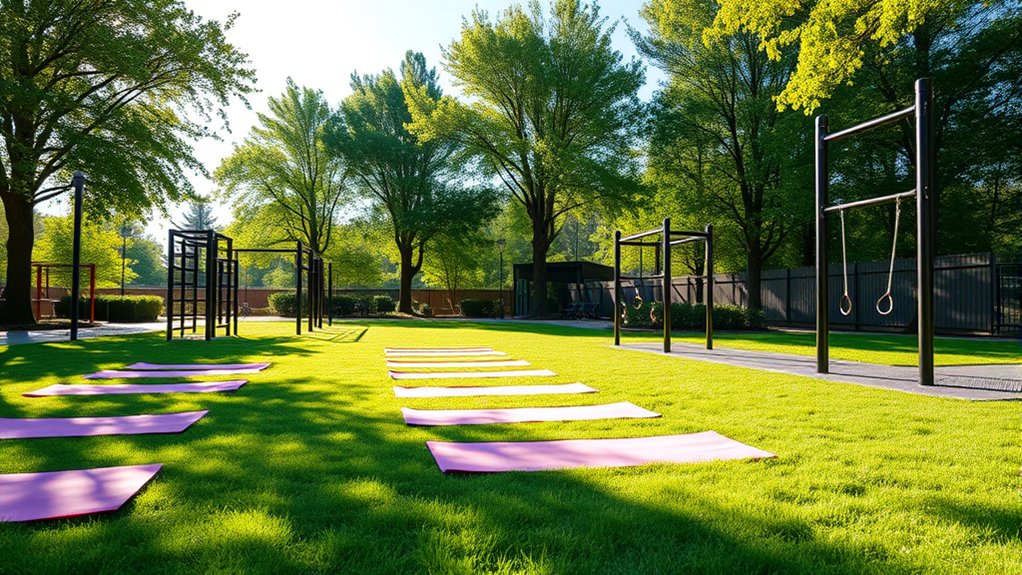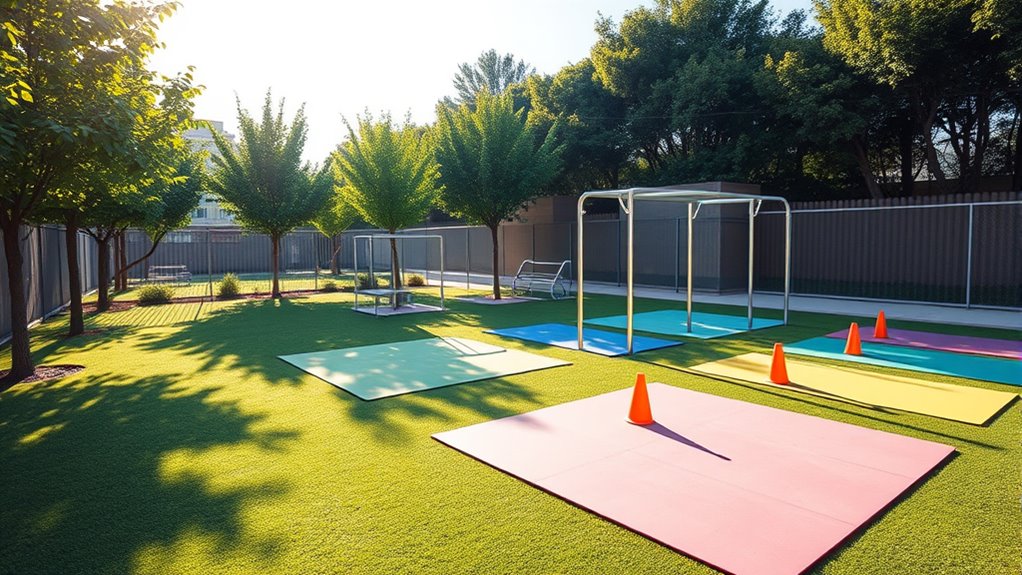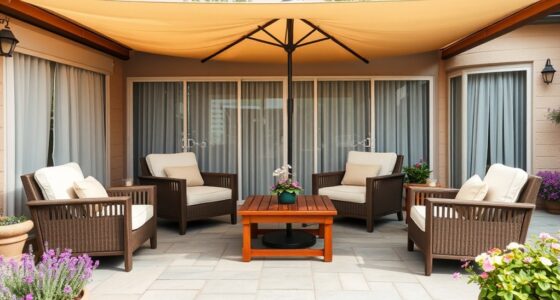To set up a safe outdoor exercise space, choose a level, accessible spot away from traffic, with firm ground like grass or rubber mats. Select sturdy equipment suited to your fitness level, and regularly check for damage. Use barriers or landscaping for privacy and wind protection, and plan for weather—adding shade or covers. Keep the area tidy and well-organized to prevent accidents. Learning more will help you create a secure, enjoyable fitness environment tailored to your needs.
Key Takeaways
- Select a level, accessible outdoor location away from traffic and hazards for safety.
- Use durable, well-maintained equipment suitable for your fitness level and goals.
- Ensure proper lighting, shade, and privacy with natural or installed features.
- Regularly inspect and clean the area, removing debris and checking for hazards.
- Incorporate safety features like padding, barriers, and good drainage to prevent accidents.

Have you ever considered how an outdoor exercise area can transform your fitness routine? Creating your own space outdoors offers the chance to enjoy fresh air while staying active, but it’s essential to plan carefully. The first step is paying close attention to equipment safety. You want your workout area to be as safe as it is effective, so choose sturdy, well-made equipment designed for outdoor use. Regularly inspect your gear for signs of wear or damage, such as rust, cracks, or loose parts. Proper maintenance not only prolongs the lifespan of your equipment but also prevents accidents. It’s also wise to select equipment that’s appropriate for your fitness level and goals, avoiding anything too complicated or risky if you’re a beginner. Simple items like resistance bands, stability balls, or a pull-up bar can be both effective and safe when used correctly.
Location selection is equally critical. You need a spot that’s accessible, level, and away from traffic or other hazards. Look for an area that gets plenty of sunlight but also offers some shade to prevent overheating, especially during warmer months. Consider the ground surface—grass, rubber mats, or even a concrete slab can work well, but ensure it’s even to prevent trips and falls. Keep in mind privacy; a semi-secluded spot can make your workouts more enjoyable without feeling exposed. You should also think about wind and noise levels; a calmer, quieter environment can help you focus and stay motivated. When choosing the location, avoid areas near busy roads, steep slopes, or uneven terrain that could compromise safety. Planting a few shrubs or installing a fence can add a layer of privacy and protection from wind. Additionally, knowing the Louisiana Civil Code guidelines related to outdoor structures and safety can help ensure your setup complies with local regulations. Incorporating appropriate safety features such as padding or barriers can further enhance your outdoor workout space. Conducting a site assessment beforehand can help identify potential hazards and improve overall safety. Also, considering weather conditions can help you plan for seasonal changes and ensure year-round usability of your outdoor space.
Once you’ve selected the perfect spot, focus on organizing your equipment thoughtfully. Keep frequently used items within easy reach, and store smaller accessories in weatherproof containers. Setting up a shaded area or canopy can protect your gear and you from the sun’s harsh rays. Remember, safety isn’t just about the equipment, but also about the environment. Regularly clearing debris, trimming nearby trees, and ensuring good drainage will keep your outdoor exercise area safe and inviting. With careful equipment safety considerations and strategic location selection, you’ll create a space that’s both inspiring and secure—making it easier to stay committed to your fitness goals and enjoy the outdoor benefits every day.
Frequently Asked Questions
How Do I Prevent Injuries in Outdoor Exercise Areas?
To prevent injuries during outdoor exercise, you should always prioritize safety. Wear proper footwear that provides support and grip to avoid slips and strains. Consider weather conditions before exercising; if it’s hot, stay hydrated and wear breathable clothing, while cold weather calls for layered attire. Warm up and cool down to prepare your muscles, and stay aware of your surroundings to prevent accidents. These steps help keep your outdoor workouts safe and injury-free.
What Is the Best Time of Day to Exercise Outdoors?
The best time of day to exercise outdoors depends on your goals and schedule, but ideal timing often is in the morning. Morning workouts can boost your energy, improve mood, and help you stay consistent. Plus, exercising early allows you to avoid peak heat and crowds. If mornings don’t suit you, late afternoon or early evening are good options, as temperatures tend to be cooler and you can wind down after your day.
How Often Should Outdoor Exercise Equipment Be Maintained?
Imagine your outdoor equipment turning into a fortress, safe and reliable for every workout. You should inspect your equipment weekly, catching even tiny issues before they become disasters. Follow a regular cleaning schedule to keep equipment spotless and germ-free. This way, you guarantee safety and longevity, preventing injuries and equipment breakdowns. Consistent maintenance is your secret weapon for an outdoor exercise space that stays inviting, functional, and ready whenever you are.
Are There Age Restrictions for Outdoor Exercise Activities?
You might wonder about age restrictions for outdoor exercise activities. It’s important to take into account age limitations and activity suitability to ensure safety. Generally, equipment is designed for all ages, but younger children should be supervised and use age-appropriate gear. Older adults should choose low-impact activities. Always check specific guidelines and consult with health professionals if needed, so you stay active safely and enjoy your outdoor workouts.
How Can I Make My Outdoor Space More Inviting?
You might think your outdoor space needs a major overhaul, but small changes can make a big difference. Add charming garden decor like colorful planters or fairy lights to create a cozy vibe. Arrange comfortable seating to encourage relaxation and conversation. These simple updates turn your outdoor area into an inviting retreat where you’ll enjoy staying active and socializing, making it a perfect spot for outdoor exercise and leisure alike.
Conclusion
Think of your outdoor exercise area as a garden where your health blooms. With each step you take, you plant seeds of strength and vigor. As you nurture this space, it becomes a sanctuary where your energy blossoms under the sun’s warm embrace. Keep tending to your safe haven, and watch your wellness grow tall and resilient—an ever-changing landscape of progress, rooted in the simple act of staying active amidst nature’s beauty.









